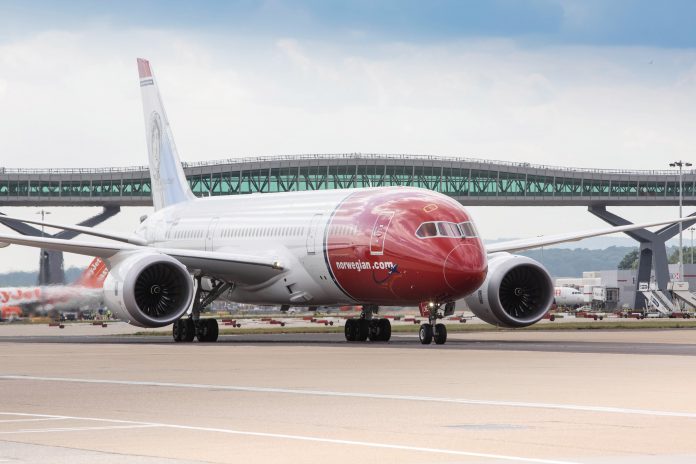Norwegian Air Group plans to quicken the pace of its transatlantic route expansion in the wake of receiving its long-awaited approval to operate U.S. flights through an Ireland-based subsidiary, a move that’s expected to bolster inroads being made by low-cost carriers in the U.S.-Europe market. “The thing that will hold us back is the number of aircraft coming in,” said Norwegian chief commercial officer Thomas Ramdahl. In early January,
Norwegian expects to make its first U.S. route announcements since the DOT approved its foreign air-carrier permit for Norwegian Air International (NAI) on Dec. 1 after a nearly three-year review. They will involve flights from Ireland to the Northeast. Norwegian has previously said it is interested in flying from Cork and Shannon to North American destinations. Ramdahl said last week that the carrier plans to fly into three new midsize airports from both Ireland and the U.K., specifically Hartford, Conn.’s Bradley Airport; T.F. Green Airport in Providence, R.I.; and Stewart Airport, located about 60 miles north of New York.
Over time, Norwegian is also looking into adding Seattle, San Diego, Houston, Chicago, Denver and the Washington-Baltimore area to its U.S. route network, he said. The carrier’s flights are often exceptionally inexpensive. One-way, no-frills fares from Boston to London, for example, were being offered on Norwegian’s website for $139 last week. Aiding Norwegian’s U.S. expansion will be its plan to take delivery next year of nine Boeing 787 Dreamliners and six Boeing 737-MAX aircraft. The carrier will be Boeing’s launch partner for the 737-MAX, a fuel-efficient narrowbody jet that will enable Norwegian to offer its cheap fares on routes serving midsize markets in the Northeast and Europe. But the bigger piece of the puzzle is the approval of Ireland-based subsidiary NAI, which Norwegian said gives it more freedom in fleet utilization, thereby making route scheduling simpler.
Norwegian operates 47 routes to Europe and the Caribbean from eight U.S. cities under the Norway-based carrier license of its Norwegian Air Shuttle. But Ireland is a member of the EU, while Norway is not, so flights using the NAI permit can more easily take advantage of EU aviation agreements than those flying under the Norwegian Air Shuttle license can. As a result, Norwegian will now be able to use the NAI license as it utilizes the same aircraft to fly some days of the week to Asia and other days of the week to the U.S., Ramdahl said. Norwegian is the lead player in the new and growing transatlantic low-cost carrier market. According to the aviation data analytics company OAG, legacy carriers still dominate that market and will fly 96.8% of the scheduled flight legs between North America and Western Europe in 2016. Still, that’s down from 98.2% in 2015 and virtually 100% as recently as 2013. This year, low-cost carriers will fly 5,529 flight legs between Western Europe and North America, up from 1,092 in 2014. Along with Norwegian, the major players in that market are Iceland’s Wow Air and, for Canadian destinations, Canada’s WestJet. Norwegian will fly 2,916 transatlantic legs this year, up from 2,018 a year ago. Wow, which connects the U.S. to Europe via Iceland’s capital of Reykjavik, launched in 2015 with 386 U.S. flight legs and will jump to 1,279 this year, according to OAG.
Wow just added Newark to its U.S. destinations, and next year it will add Miami and one or two other destinations, said CEO Skuli Mogensen, who said he expects the airline’s overall North America seat capacity to double next year. Legacy carriers are taking notice of their low-cost transatlantic competition, especially as unit revenues on transatlantic flights have dipped faster in recent quarters than revenue for other markets. In its third-quarter earnings report, for example,
Delta president Glen Hauenstein said the carrier needs to look at its entire transatlantic product in order to compete with low-cost carriers. “The closer we can get to what our customers want to buy in every sector, the better off we will be,” Hauenstein said. Meanwhile, in November, British Airways announced plans to compete directly against Norwegian on routes from London Gatwick to Oakland, Calif., and Fort Lauderdale beginning next year. One-way fares on the Oakland flight started at $299. Mogensen said that transatlantic low-cost service is only going to expand and get cheaper over time. “I think we are definitely just at the starting


























